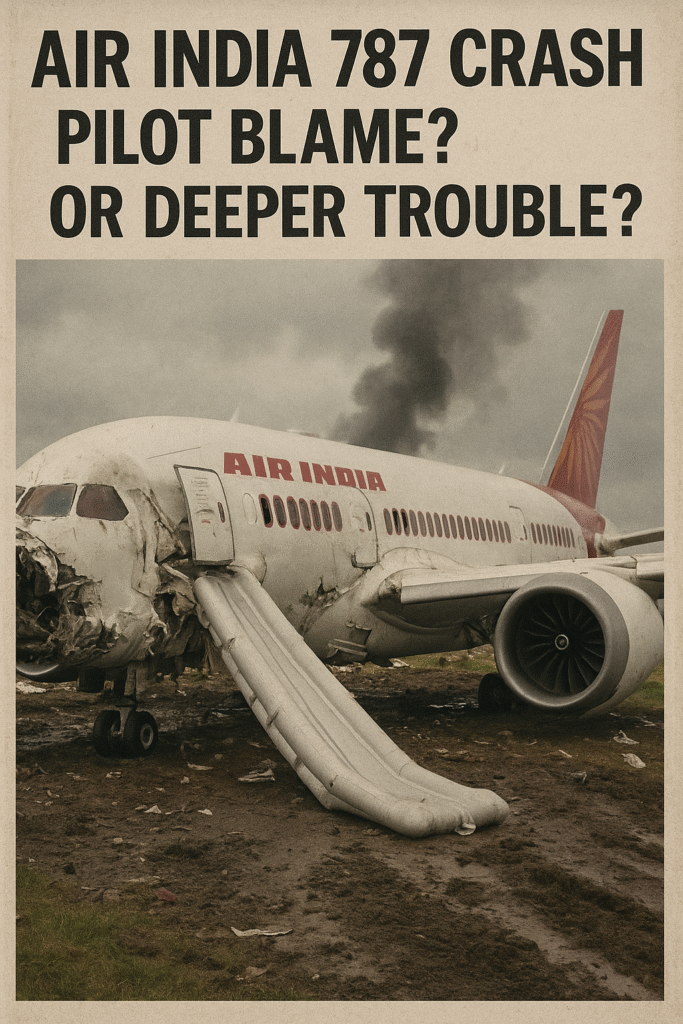The tragic crash of Air India’s Boeing 787 Dreamliner has sent shockwaves through the global aviation community. What was initially presumed to be a technical failure has now taken a dramatic turn, with investigators focusing on possible human error. Here’s a clear, comprehensive explanation of what we know so far.
What Happened?
Shortly after takeoff, the aircraft suffered a sudden dual engine failure, leading to the crash. Initial fears pointed towards a mechanical fault, but both Indian and U.S. aviation investigators have now confirmed that no technical or maintenance issue was found with the aircraft or its engines.
According to preliminary data recovered from the cockpit voice recorder, the captain may have inadvertently or intentionally cut off both fuel-control levers within seconds of each other, causing the engines to shut down mid-air. The first officer is reported to have reacted with alarm, questioning the decision in a panicked voice.
Focus on the Captain’s Actions
The focus has now shifted to senior pilot Captain Sumeet Sabharwal, with international reports suggesting he may have manually toggled both fuel switches to the “CUTOFF” position. This rare and dangerous move would cause both engines to lose power simultaneously—a virtually unrecoverable event so soon after takeoff.
What Foreign Media is Reporting
Prominent foreign media outlets like Reuters, The Wall Street Journal, and Financial Times have highlighted the role of cockpit decision-making in the crash. The Wall Street Journal cited U.S. officials stating the engine shutdowns were not caused by mechanical issues but by human input, suggesting a tragic error in judgment or possible confusion.
In addition, U.S. aviation analyst and retired pilot Steve Ganyard told WSJ that such an action—turning off fuel switches in flight—is almost unheard of and not part of any standard operating procedure. He emphasized the need to better understand cockpit human factors and decision-making under stress.
Indian Pilots Push Back
However, back home in India, aviation unions and pilot groups have urged caution. Many pilots believe it is premature to lay blame on the captain without a full, transparent investigation. “It’s deeply irresponsible to jump to conclusions,” said a senior Air India pilot, adding that there could have been system miscommunication or a malfunction in the cockpit interface.
India’s Aircraft Accident Investigation Bureau (AAIB) also criticized speculative reporting, calling it damaging both to the investigative process and to public trust. The agency insists a final report is still months away and will include technical, human, and systemic analysis.
Global Safety Reactions
In response to the incident, several international airlines—including Lufthansa, Singapore Airlines, and Japan Airlines—have initiated inspections on Boeing 787s and certain 737 models. The checks, focusing on fuel switch locking mechanisms, have revealed no mechanical faults so far. This global response underlines how seriously the aviation world is treating the crash.
What Happens Next?
The final investigation report will likely include voice recordings, technical data, pilot training records, and input from human factors experts. There’s also renewed discussion about mandating cockpit image recorders in commercial jets—a controversial but increasingly supported safety measure.
Conclusion
While the possibility of human error is at the forefront of this tragic event, it’s vital to wait for the full investigation before drawing conclusions. Both the Indian and global aviation sectors are watching closely, hoping for answers that will not only explain what happened—but help prevent it from ever happening again.
Stay tuned to Akhbaar Express for accurate, responsible coverage of this developing story. Follow our Explained section for more such news!

